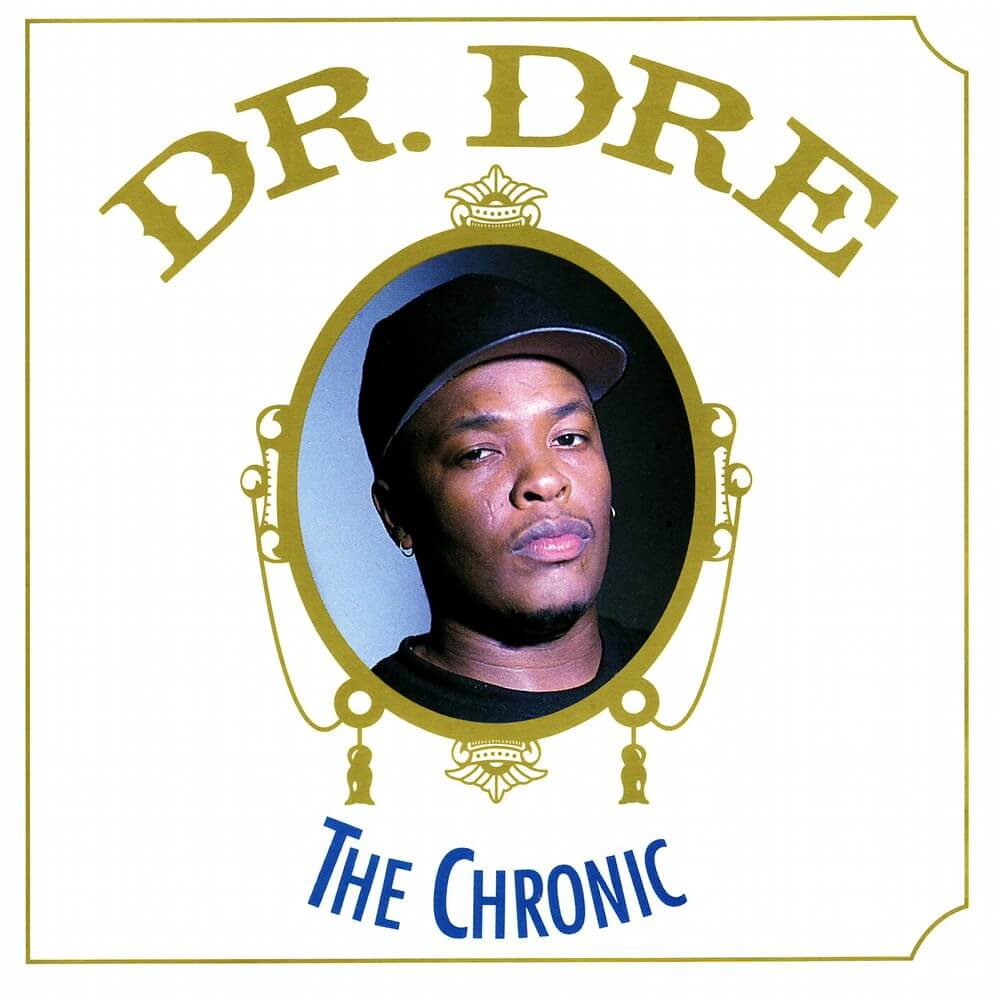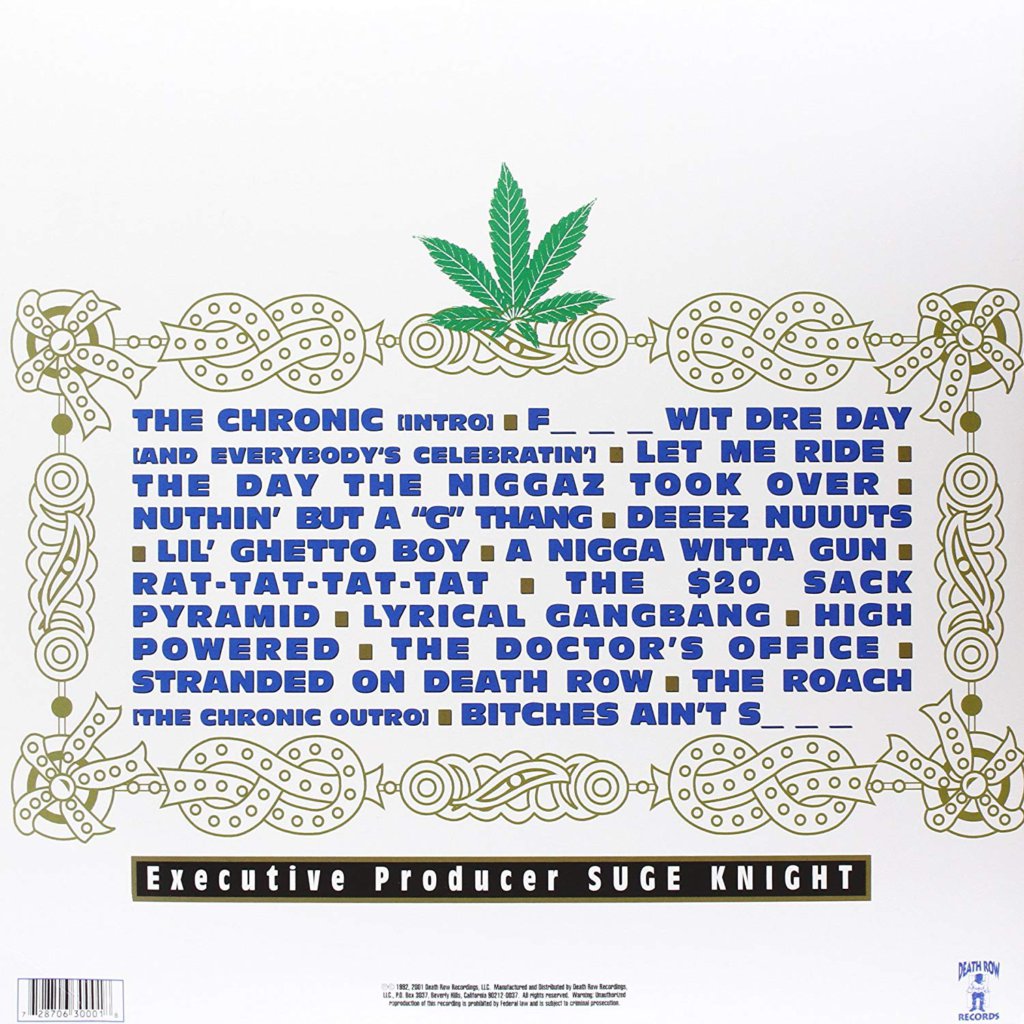
Dr. Dre’s The Chronic is an iconic album that dropped in 1992 and flipped the script on West Coast Hip Hop, Hip Hop as a whole even. This record presented a sonic revolution that changed the game and set the stage for G-funk domination.
From the jump, The Chronic hits you with that unmistakable Dre production. We’re talking thick, syrupy basslines, high-pitched synth whines, and drums that knock so hard they’ll rattle your trunk. Dre took the P-funk sound, chopped it up, and reassembled it into something new. Tracks like “Nuthin’ but a ‘G’ Thang” and “Let Me Ride” are textbook examples of this new G-funk sound – laid-back yet hard-hitting, smooth yet street.
But this album isn’t all about the beats. Dre brought in a murderer’s row of emcees to spit over his production, and chief among them is a young Snoop Doggy Dogg. Snoop is the album’s main attraction, laying the groundwork for his own solo debut Doggystyle which would drop in 1993. His laid-back, melodic flow and distinctive drawl perfectly complement Dre’s beats. From his scene-stealing verses to his iconic ad-libs, it was clear a new star had been born.
On tracks like “F*** Wit Dre Day” and “Nuthin’ But a G Thang,” Snoop proves why he’d go on to be one of the biggest names in Hip Hop. RBX brings a unique, gravelly voice to tracks like “Lyrical Gangbang” and “High Powered.” Daz shows early signs of the skills that would make him a key player in West Coast Hip Hop. The Lady of Rage holds her own amongst all the testosterone on “Stranded on Death Row,” and Kurupt would go on to be recognized as one of the best technical rappers to ever emerge from L.A.
Speaking of “F*** Wit Dre Day (And Everybody’s Celebratin’),” this track is a masterclass in how to craft a diss record. Dre and Snoop go in on Eazy-E, Tim Dog, and Uncle Luke with precision and flair. The beat is menacing and the verses are filled with quotable lines. It’s the kind of track that ends careers. And we can’t talk about The Chronic without mentioning the posse cuts. “Stranded on Death Row” brings together Kurupt, RBX, Snoop, and Lady of Rage for a lyrical onslaught that’ll leave your head spinning, and “Lyrical Gangbang” is just as hot.
Lyrically, The Chronic covers familiar gangsta rap territory – violence, guns, drugs, and misogyny are all here. But don’t get it twisted, this isn’t all posturing and party anthems. Take “Lil’ Ghetto Boy” for instance. This track hits different, with Dre and Snoop painting a vivid picture of life in the hood, touching on the cycle of violence and the struggle to break free. It’s a moment of reflection that adds depth to the album’s narrative. And we can’t sleep on “The Day The N***** Took Over.” This track is raw, urgent, and unapologetically political. Sampling news reports from the 1992 LA riots, it captures the anger and frustration of a community pushed to the brink.
And as much as The Chronic has its serious moments, it’s also funny as hell. “A N**** Witta Gun” is straight-up hilarious, with Dre and Snoop trading punchlines over a bouncy beat, and “Deez Nutz” is so ridiculous it shouldn’t work, but somehow it does. Skits top this album off. Yeah, they’re crude and over-the-top, but they add to the cinematic feel of the album. Listening to The Chronic is like watching a movie about early ’90s LA – you get sucked into this world of lowriders, chrome, and palm trees.
Now, let’s address the elephant in the room – some of the content on The Chronic is problematic. The misogyny and homophobia are hard to ignore, and they definitely date the album. But to understand The Chronic, you have to put it in context. This was gangsta rap at its peak, pushing buttons and causing controversy left and right. Take “Bitches Ain’t S***,” for example. The misogyny is off the charts, and it’s definitely the low point of the album content-wise. But musically? That beat is smooth as butter. It’s a prime example of how Dre could make even the most offensive content sound good – something already shown on the last N.W.A. album Efil4ziggan (1991).
Production-wise, The Chronic is a masterclass. Dre’s use of live instrumentation alongside samples created a rich, layered sound that was miles ahead of what anyone else was doing at the time. The way he flips Parliament and James Brown samples on “Let Me Ride” is nothing short of genius. And that synth line on “Nuthin’ but a ‘G’ Thang”? Iconic. Let’s take a moment to appreciate the mixing on this album. The way Dre balances all the elements in his productions is incredible. Take “Let Me Ride” – you’ve got the thumping bass, the airy synths, the crisp drums, the vocal samples, and the raps, all sitting perfectly in the mix without overpowering each other. It’s the kind of technical excellence that elevates good music to great music.
Now, we have to talk about the cultural impact of this album. The Chronic didn’t create gangsta rap, but it sure as hell pushed it to the forefront of the mainstream. Suddenly, suburban kids were bumping G-funk in their parents’ minivans. It changed the sound of Hip Hop, the look of Hip Hop, and the business of Hip Hop. Its unabashed celebration of cannabis use played a role in shifting public perceptions of marijuana. The lifestyle portrayed in the lyrics and videos – a mix of street hustle and lavish parties – became a template for Hip Hop aspirationalism that persists today. The videos for tracks like “Nuthin’ but a ‘G’ Thang” and “Let Me Ride” popularized a whole aesthetic – Dickies suits, Chuck Taylors, lowriders. It wasn’t brand new, but The Chronic brought it to the mainstream in a big way.
Sonically, The Chronic still holds up today. That’s a testament to Dre’s skills as a producer and engineer. The mix is clean and well-balanced, allowing you to hear every layer of the production. It sounds as good on high-end speakers as bumping out of a Jeep or on your headphones. One of the coolest things about The Chronic is how it bridges the gap between old school and new school. Dre’s production draws heavily on 70s funk but flips it into something futuristic. The Chronic also redefined the role of the producer in Hip Hop. Before this album, producers were often in the background, but Dre put himself front and center. He wasn’t content to stay behind the boards – he wanted to be a star in his own right. This shift paved the way for producer-rappers like Kanye West and opened up new possibilities for how Hip Hop albums could be structured.
Now, is The Chronic perfect? Well no, but nothing is. Some of the attitudes expressed in the lyrics are pretty hard to swallow in the 2020s. And if you’re not into the whole gangsta aesthetic, this album might not be for you. But even with its flaws, The Chronic is a crucial piece of Hip Hop history. Over thirty years on, the influence of The Chronic is still felt in Hip Hop. You can hear echoes of its sound in countless rappers and trappers. The G-funk genre it popularized might not be as dominant as it once was, but its DNA is still present in modern production.
At the end of the day, what makes The Chronic special is how it all comes together. The beats, the rhymes, the attitude – it all gels into something greater than the sum of its parts. It’s an album that captures a moment in time while still feeling timeless. It’s a time capsule of a specific moment in rap history when the West Coast was ascending and gangsta rap was becoming a cultural phenomenon. But more than that, it’s a damn good album. The beats knock, the flows are smooth, and the overall vibe is undeniable.
The Chronic is a cultural touchstone that continues to influence and inspire over three decades after its release. It changed the sound of Hip Hop, launched careers, and brought the West Coast sound to mainstream domination. Its fusion of old-school funk with modern production techniques, its introduction of new lyrical talents, and its unapologetic attitude have ensured its place in the pantheon of classic Hip Hop albums. Love it or hate it, you can’t deny its importance in the Hip Hop canon.
So whether you’re revisiting it for nostalgia or if you’re a young one checking it out for the first time, give The Chronic a spin. Turn it up, let those G-funk synths wash over you, and transport yourself back to ’92 – and experience a snapshot of a moment when Hip Hop was being reshaped in real-time by one of its most visionary artists.

